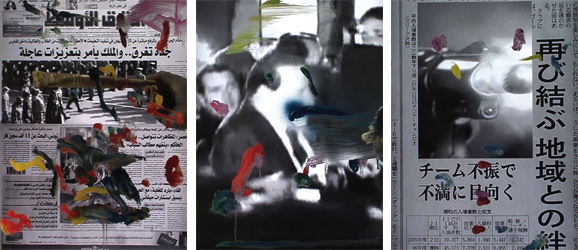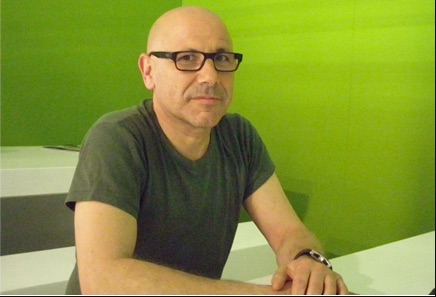For many years, the work of the Belgian artist Angel Vergara (*1958, Mieres, Spain) has used different media such as drawing, video, installation and performance, allowing him to explore and broaden the limitations of painting both from an aesthetic and socio-political perspective. His more recent works make use of film and video and it is through this flux or stream of images that he creates or renders possible “live paintings”, a painting that is created in sync with the flow of images on the screen. The same gesture takes place within a mediatized reality when Vergara appropriates existing images. His assertion of his position as a painter is nothing more than an abstract concept: when he interacts with reality, he often occupies an economic and social function though which he seeks to explore the limits of the role of the artist.
For the 54th Venice Biennale, Angel Vergara presents in the Belgian Pavilion the exhibition project “Feuilleton”, curated by Luc Tuymans, from 4th June to 27th November 2011.
Selina Ting
Brussels, July 2011
AV – Angel Vergara
ST – Selina Ting for InitiArt Magazine
ST : How did you feel when you know that you were chosen for the national pavilion?
AV: Fantastic! It’s a big challenge… Four artists were selected and we had two months to come up with a project, then my project is taken. I am really happy to be present in such an important event. Because in Belgium, we are the capital of Europe and we don’t even have a contemporary art museum. Art venues are very limited for living artists. We have a lot of good artists and we are bored with the situation. For me, it’s a big challenge to be in Venice.
ST : Is it your idea to invite Luc Tuymans to be the curator of the show?
AV: Yes, I invited him and it was fantastic that he accepted. It’s important to work with another artist, especially an artist from the other community [Flemish]. And immediately we are in the same language, same vocabulary. We discovered each other and got to know better each other’s work since the collaboration. Though our practices are very different, it’s amazing to find a lot of similarities between us in regards to history, memory, identity, etc. It is a big experiment! Besides, Luc is a very experienced curator as well. I am very happy working with him.

ST : I read that you hijacked the national pavilion in 1988 when you disguised for the first time as Straatman.
AV: Yes, that was the first time I was in Venice Biennale and the first time I did the Straatman. I wanted to situate the artist studio in the normal system and to position the artist in the world, and I wanted to be directly acting at the middle of the city’s public space. I did it in the Giardini where I covered myself in a piece of white sheet, like a canvas, and I put myself at the middle of the context.
ST : Was it a performance?
AV: It was like a performance, but for me it was not a performance. My idea was to find the best condition to do paintings today. You know how photography works… my idea was the same. Under the canvas, my whole body was open to light, and I painted what was happening around me. I didn’t really look at my subject or the landscape. I didn’t see anything. All my other senses were reacting, detecting, and my psychology and imagination were expanded.
ST : How did the public react to it?
AV: Some people walked to me to check if I was dead, and what I was doing, etc. Sometimes the police came as well. It was a very complex situation. But after 9˙11, it became too complicated to do such kind of project at the centre of the city.

ST : You have chosen the title “Feuilleton” for the Belgian Pavilion which you represent in the 54th Venice Biennale. The title is also announced in a light-box at the entrance of the pavilion. The word itself usually refers to serial stories run in newspapers. Why did you choose “Feuilleton”? What are your interpretations?
AV: In French, literally “Feuilleton” means a scrap of paper. When it first appeared in the 19th Century, it referred to the newspaper industry where serial stories and political gossips were published. In the post-war era when TV series began to appear, they were referred to as the “Feuilleton” too, kind of the francophone equivalent to “soap opera”. In the Belgian Pavilion, you have three interpretations. Firstly, it’s the “Feuilleton” of the paintings, which means inside the pavilion, you can see in full-screen the seven deadly sins in video projections, then you have paintings and postcards, etc. The second interpretation refers to the current political situation and approach in Belgium, i.e. we don’t have a government. The third interpretation is the “Feuilleton” of the world.
ST : The seven deadly sins have long been a subject in the history of painting. What are your new approaches to the subject?

AV: The interpretation of the seven sins changes with times, social contexts and morality. I take the seven sins in this instability concept. My approach is to create seven series of stories, each with one sin as its focus. All the stories are composed of images extracted from newspapers, so they are about today’s society. At the same time, I add some historical references, such the figure [Pier Paolo] Pasolini who, in this context, represents the death of reality and the death of poetry. The structure of the stories is a bit like the American TV series CSI or Les Experts in French. Because then we have scientific police who come to investigate the crime scene…
ST : Can we say that there is a narration in each episode though the development is not constructed?
AV: Yes.
ST : We see quite often religious paintings that dealt with the seven sins…
AV: Yes, and at one time painting itself was a sin as well [Laughs] because of violence and obscenity, etc. But at the same time, philosophers such as Paul Valéry said that, to be a full human being, we need to practice a little bit of the each of the seven sins. [Laughs] And I think for a painter, it’s absolutely right to practice a bit of the sins!!
ST : To live fuller!!
AV: Yes, but of course in the poetic sense!
ST : We need to experience all the emotions.
AV: Yes and these kinds of emotions are very important in the philosophy of Spinoza. There is a big debate on how to deal with these emotions or sins. But my vision is not moralist. Just that we are living in a time of troubles, and I find a parallel with some apocalyptic paintings, like the paintings of Jérôme Bosch [v. 1453 – v. 1516] and Van Gogh, etc. With all the recent political, social and economic unrests, and all the catastrophes, the world looks very similar to those paintings. My vision of history, life and art is in relationship to the reality, not religion.

© Angel Vergara.
ST : Reality is instable, history is shifting and life is never certain, all these correspond to your manner of painting on the moving images. You started painting when painting was said to be dead. Then you paint on films, like an act of interacting, capturing the images which are disappearing…
AV: Yes, it’s moving, it’s changing, it’s never stable, but the painting comes over the moving images and stays as a more stable form. All the projects are painting projects, and all the films are in confrontation with the images. It’s a different language, and this language has more stability than the images themselves. There is the permanence of the sign, and the possibility to accept a lot of images accumulated at the same time and space. When the image disappeared, the signs stay, and they start interacting with the new image and creating new meanings and readings.
ST : Because it becomes something else…
AV: Yes ! The first time when I noticed this, I was very surprised, amazed. The signs stay, but they stay in accordance with the following image and the infinite succession of images.
ST : At the same time, they are the traces from the past. They are signs of a previous movement that have an impact on the here and now.
AV: Yes, the consciousness of the past is very important. I think in general, the sense of past and history plays a significant role in an artist’s work. Today, we need to live in the immediacy, like the images, constantly moving, shifting, changing. But history is important for us to know where we are from and where we are heading to. When I started researching on the seven sins, I read a lot of historical paintings, and these classics helped me to understand the presence that we are living in.
ST : What is poetry to you? You like to make references to poetry.
AV: Poetry is for the moment the most fragile art, it’s not disappearing but we are not so concerned with it. In the older time, the figure of poet is very reverent. Today, they are very much marginalized and artists busy themselves with the market. It’s very difficult to keep the integrity.
ST : Thank you!

About the Artist
Born in Mieres (SP) in 1958, Angel Vergara lives and works in Brussels.
His recent solo exhibitions includes Feuilleton, The Belgian Pavilion at the Venice Biennale. In 2010: Acts and Paintings, IKOB, Eupen, Belgium; Second Life, Laura Mars Gallery, Berlin; Monday : Firework ; Tuesday : Illuminations ; Wednesday : Revolution, Argos Centre for Art and Media, Brussels; Solo Projects, Stella Lohaus Gallery, ARCO, Madrid. 2009: Nous, les oeuvres d’art…, Etablissement d’en face projects, Brussels. 2008: Art Première, Art Basel (with Joëlle Tuerlinckx), Stella Lohaus Gallery, Antwerp.
